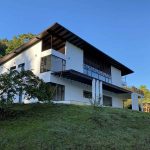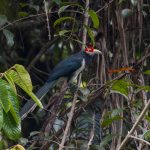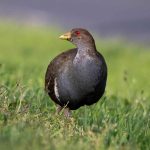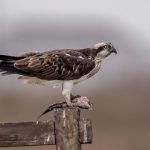On Saturday, September 1, 2007, Will and I participated in the Hudson-Mohawk Bird Club’s first Fall Century Run. Was the best part of the day watching a flushed American Bittern fly over a marsh? Or was it when a flock of noisy Blue Jays went in a screaming chase after a Great Horned Owl? Or maybe the sighting of a flock of fifty-plus Blue-winged Teal? Could it have been a Peregrine Falcon in pursuit of a Ring-billed Gull? No, no, no and no!
The highlight, for me anyway, was a mixed flock of warblers that included a lifer and a year-bird! But I’ll get to all that good stuff in a bit. First, some explanation of what the heck I’m talking about when I say we were on a Century Run.
Unlike the usual May Century Run where the goal is for your team to reach at least 100 bird species for the day, the goal of this Century Run was for the entire region to reach 100 species for the day. In the area around Albany, New York this time of year it’s tough to get that many birds. Will and I still thought we had the chance to make 100, but decided not to exhaust ourselves to do it. We would skip owling and other night-birding and just start at sunrise and go until near sunset.
We began at 6 AM at Vischer Ferry in southern Saratoga County, where we were joined by another local birder, Zack, who could only bird with us for the morning. Vischer’s fog-shrouded marshes and ponds were rather lackluster at first, but we were there mostly to get into the forested sections in the south and west of the preserve in the hopes of finding mixed-species foraging flocks of migrants (even more lackluster was my preparation for the day, as I discovered when I attempted to take a nice scenic picture of the dawn light on foggy marsh…I forgot to put a battery in my camera. Doh!).
Unfortunately, the flocks didn’t want to be found. Sure, we picked up some of the resident birds like Rose-breasted Grosbeak, Common Yellowthroat, Green Heron, Wood Duck, Great Blue Heron, Cedar Waxwing, Hairy, Downy, and Red-bellied Woodpeckers and some migrants like Purple Finch and Yellow-throated Vireo but we couldn’t seem to track down a nice mixed-species flock. We had a brief glimmer of hope when some chattering Black-capped Chickadees and Tufted Titmice moved through the thick foliage but all that was traveling with them were a couple Magnolia Warblers. Nice, but not enough. Where were the migrants?
Then, when hope was flagging and talk had turned to times of better birding luck, chip-notes reached our ears. And the leaves were moving not just from the wind, but from birds! Our voices went silent and up went our bins. “Chestnut-side” announced Zack, “Fifteen feet up on the right side of that large tree.”
“Redstart” Will retorted, “to the left of the chestnut.”
And so it went, as in addition to the Chestnut-sided Warbler and American Redstart we added Black-throated Green Warbler and another Chestnut-sided Warbler. Then Zack said “Tennessee Warbler” and my heart skipped a beat as my eyes strained to get on the bird. There, that drab little warbler with a line over its eye. Yes, a lifer! Wait, what’s that next to it, with the bold wing bars? Let’s see, reddish-orangish down the flanks, the same color but lighter in its undertail, “Bay-breasted Warbler” I shouted.
A lifer and a year bird within seconds of each other! And both of them warblers! Even if we hadn’t found another bird for the rest of the day I’d have been content.
But other birds we did find, including the aforementioned Blue-winged Teal and American Bittern. I also managed to embarrass myself again with a shorebird by trying to make a high-flying Spotted Sandpiper into a Least Sandpiper, but hey, I’m no expert. We left Vischer Ferry and Zack at about 11 AM with 63 species of birds checked off and headed for our next stop, the Albany Pine Bush.
En route we picked up a roadside Red-tailed Hawk at its usual hangout where Route 7 crosses the Northway and Turkey Vultures over the dump that borders the Pine Bush. Walking through the pines we heard Red-breasted Nuthatches and Eastern Towhees but saw neither. Then I announced to Will that my “spidey-sense” was tingling and the words were no sooner out of my mouth then a Sharp-shinned Hawk, mobbed by crows, perched in a pine tree not fifty feet from us. We watched the young bird interact with the crows for a bit until we remembered we had more birds to see and continued down the trail to where we could get a good view of the dump, where we hoped to find a Black Vulture among the many Turkey Vultures who make the dump their buffet restaurant. We had no luck with Black Vultures but were very pleased to hear a Black-billed Cuckoo calling, a bird we had no reasonable right to expect, so we hadn’t, but there it was nonetheless. We also managed to hear some Fish Crows calling amid the hundreds of American Crows.
Our next area of concentration was some bodies of water in southern Albany and northern Green Counties: Stanton Pond and the Alcove, Basic Creek, and Coxsackie Reservoirs. The smallest one, Stanton Pond, was the only productive one, and we added Gadwall, Barn Swallow, and a non-avian, a Red Fox, to our day list. This was really the only car-birding we did the entire day and it was really kind of a drag. Not that we had expected tons of waterfowl this early but it would have been nice to get something other than Gadwall and the ubiquitous Mallards and Canada Geese.
On we went to the Coxsackie Creek Grasslands Preserve where we saw lots of frogs and dragonflies but only one new bird, a flock of winter-plumaged Bobolinks gathering together before heading off to South America. A stop at Vosburgh Marsh where we hoped to find the only reliable Mute Swans in the area came up empty, well, empty if you discount the fly-by Osprey and the screaming flock of Blue Jays chasing a Great Horned Owl through the trees.
From Coxsackie we made our way north along the river, seeing nothing of note. When we reached the Thruway entrance in Selkirk I, the driver, overruled Will’s objection that we would miss a good field that might hold Wild Turkeys by telling him that “Turkeys are always hanging around exit 23 in Albany, we’ll see them there,” and steered onto the Thruway. I was nervous, as in May my “guaranteed” American Bittern had failed to sound off in the cold rain, but sure enough we spotted three Wild Turkeys in the grassy margin on the side of the Thruway as we exited in Albany.
At Papscanee Island we heard a Carolina Wren along the north entrance road and spotted a juvenile Northern Harrier over the fields that also held another large flock of Bobolinks. We actually entered the preserve from the south entrance but found nothing except a Ruffed Grouse that almost made me mess myself when it erupted from the ground less then three feet from the trail. Where’s my “spidey-sense” when I really need it?
Our final stop of the day, Cohoes, netted us a shorebird and gull bonanza (well, for the capital region of New York anyway), when we spotted Greater and Lesser Yellowlegs, Least Sandpipers, Semipalmated Plovers, a Herring Gull and a Great Black-backed Gull. We also spotted a Merlin, a Common Merganser and a Chimney Swift and watched a Peregrine Falcon half-heartedly chase a Ring-billed Gull.
We ended the day after Cohoes, though we still had a good hour of daylight left, as Will had to get home and I had to get ready for a full day of birding on Sunday. Our total for the day was a very respectable 90 species. You can see the almost complete list here in Will’s posting to the local listserv (he forgot Common Merganser and unidentified Empidonax flycatcher). And if you want Will’s full account of the day on his blog click here.













Hey, neither of you told me it was THAT good in NY. I’d have flown across if I’d known (no, not really, on baby duty, but if I could’ve I would’ve 🙂 …
Wait until you read about Sunday!
It took me the whole month of January just to get 95 birds.-I would think that it would be tough to hit 100 in 1 day.-Even as a group.-Looks like you saw a lot of great birds!
We might have also had American Wigeon as well…
@ Larry: We did see a lot, and if you spend a whole day hitting all of your local hotspots I’m sure you could come close…
@Will: I knew that bird was a wigeon! But no, you had to dispute it…gadwall, my butt. 🙂 (by the way folks, the bird was really, really, far away).
Sounds like an awesome day and congrats on the lifer!!!